This post may contain affiliate links. Please read our policy page.
Embracing a minimalist lifestyle in your dining room using upcycled fabric has been a transformative journey for me. I focus on clean lines and neutral tones, letting each unique fabric tell a story. By reupholstering chairs or crafting a table runner, I blend sustainability with style, creating a warm, inviting space. It’s about finding beauty in simplicity and making thoughtful choices. If you’re keen to explore more ways to incorporate upcycled fabric, I’ve got plenty of creative ideas to share!
Understanding Minimalism in Home Design
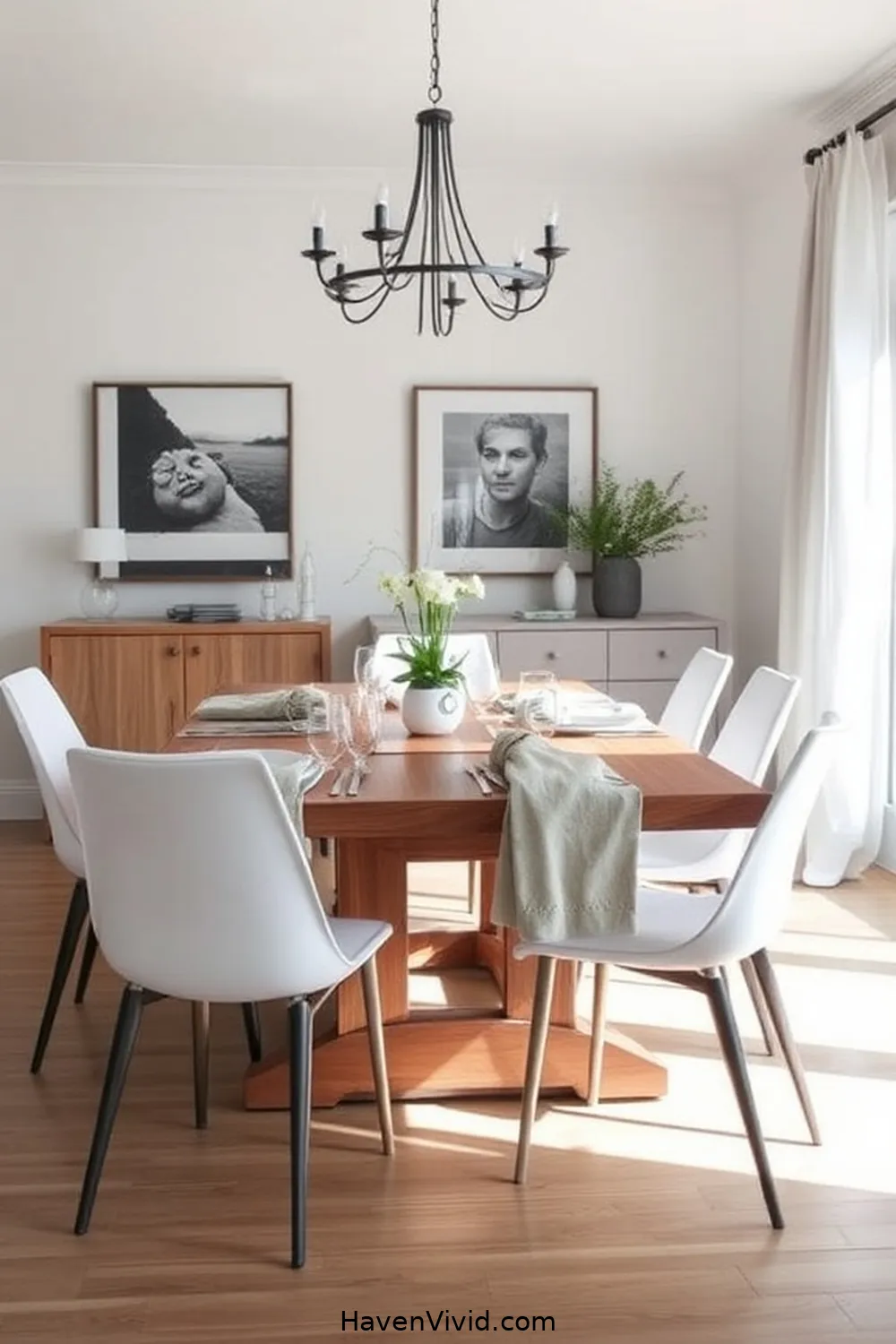
When I think about minimalism in home design, I envision a space that breathes simplicity and purpose. I see clean lines, neutral colors, and carefully chosen pieces that evoke tranquility. Each item has significance, contributing to a cohesive aesthetic.
Minimalism in home design embodies simplicity and purpose, where every piece contributes to a serene and cohesive aesthetic.
It’s about creating an environment where I can focus on what truly matters, free from visual clutter. I’ve found that minimalism encourages a sense of calm, allowing me to appreciate my surroundings more deeply.
It invites natural light to dance across surfaces, making the room feel alive and welcoming. By embracing minimalism, I can curate my dining space to reflect my values—thoughtful design, functionality, and beauty.
This intentional approach transforms not just the room, but my entire experience of home.
The Benefits of Using Upcycled Fabric
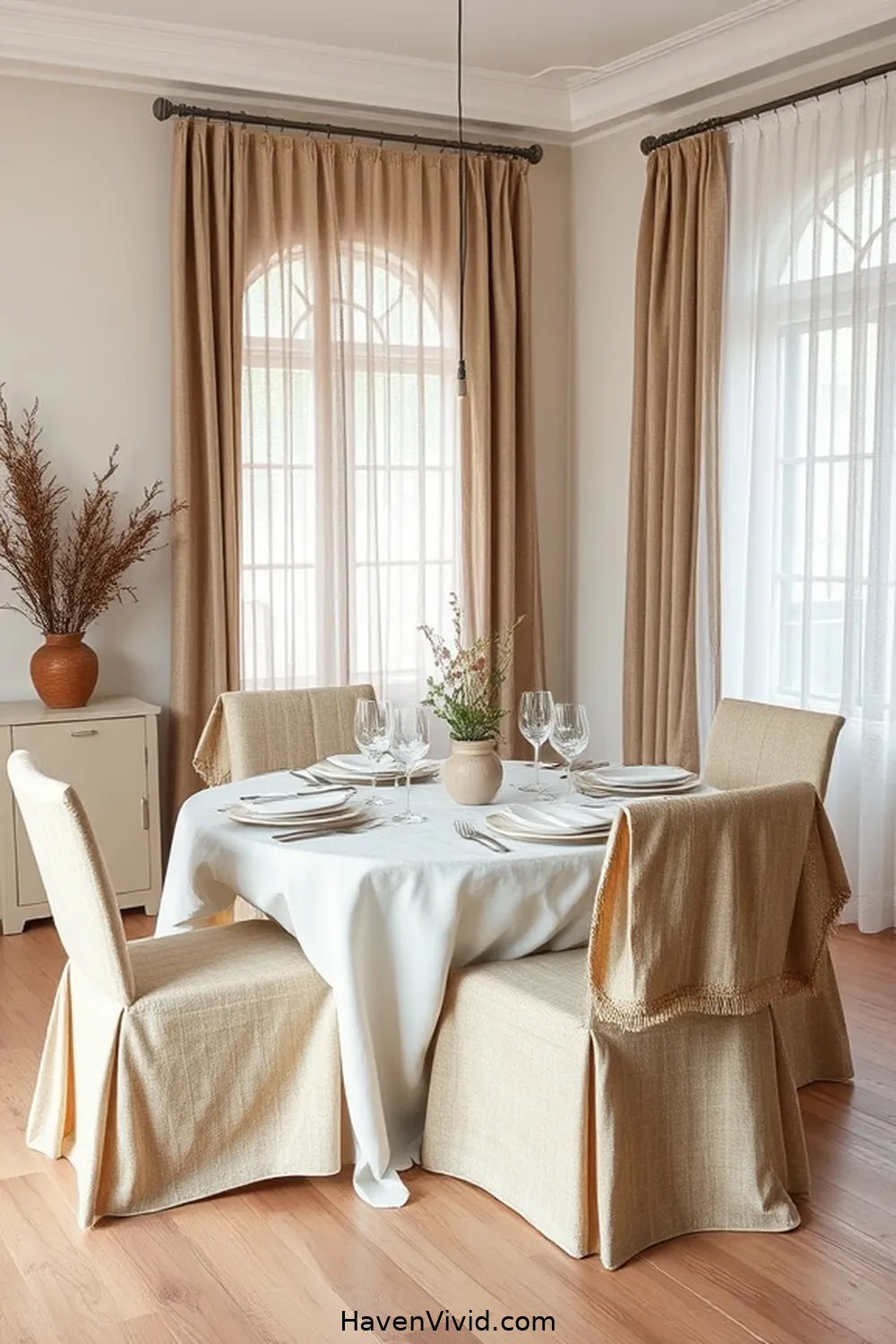
While exploring ways to enhance my minimalist dining room, I discovered the incredible benefits of using upcycled fabric. First, it’s a sustainable choice that reduces waste and gives new life to materials that might otherwise end up in landfills.
I love how each piece tells a unique story, adding a personal touch to my space. The vibrant colors and textures of upcycled fabrics can effortlessly elevate the aesthetic, making my dining area feel warm and inviting.
Plus, using these fabrics often saves money compared to buying new. It’s gratifying to know that my choices contribute to a more sustainable future while creating a stylish, minimalist environment.
Upcycled fabric truly blends creativity with practicality, and I couldn’t be happier with the results.
Choosing the Right Upcycled Fabrics
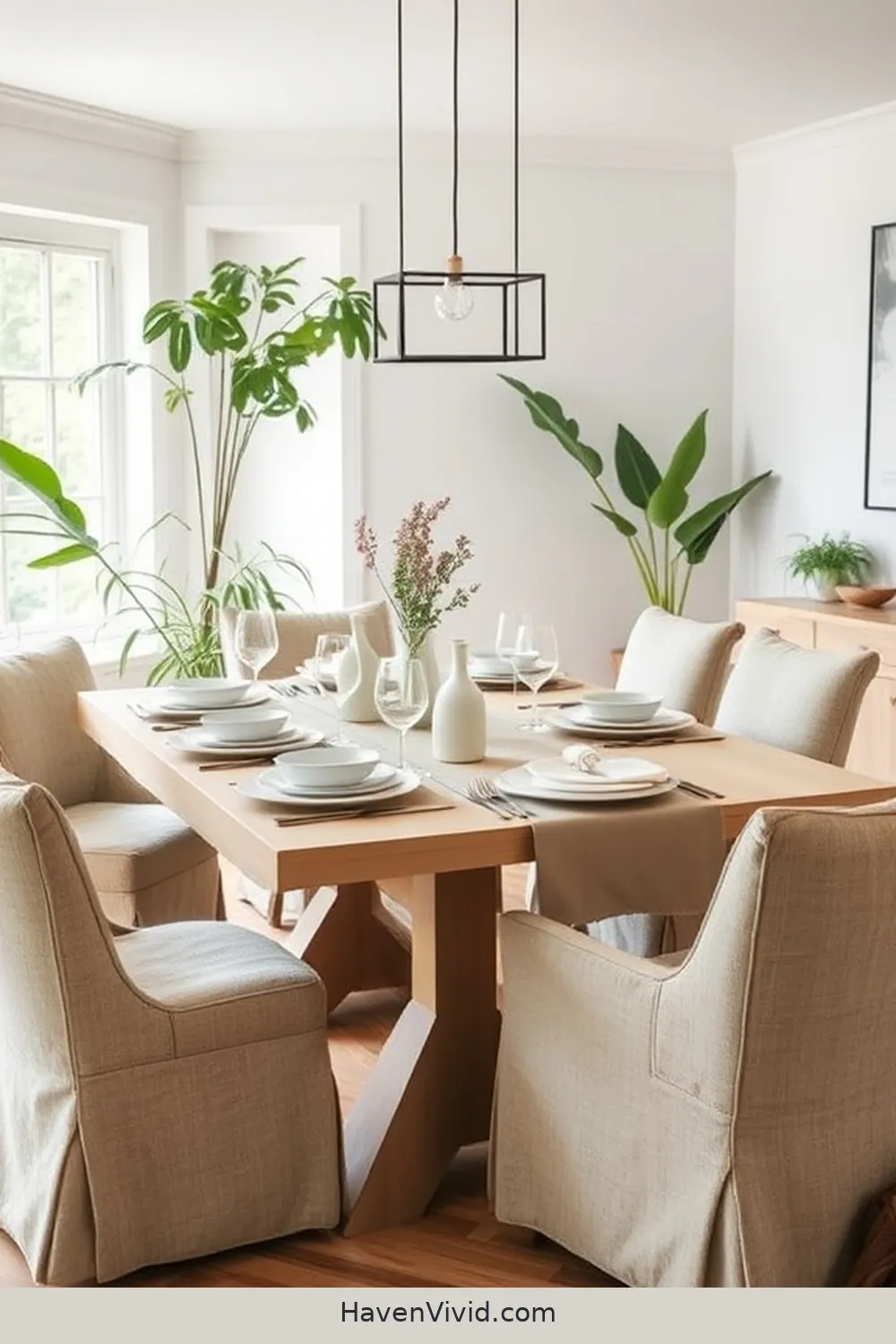
How do you choose the right upcycled fabrics for your minimalist dining room? It’s all about finding materials that resonate with your style while keeping simplicity in mind.
When I select fabrics, I look for a few key qualities that enhance my space:
- Natural fibers: They breathe and add warmth.
- Neutral colors: Soft tones blend seamlessly with minimalist decor.
- Durability: I want fabrics that withstand everyday use.
- Unique patterns: Subtle textures can add character without overwhelming.
- Ethical sourcing: Knowing the fabric’s story adds depth to my choices.
Transforming Dining Chairs With Upcycled Upholstery
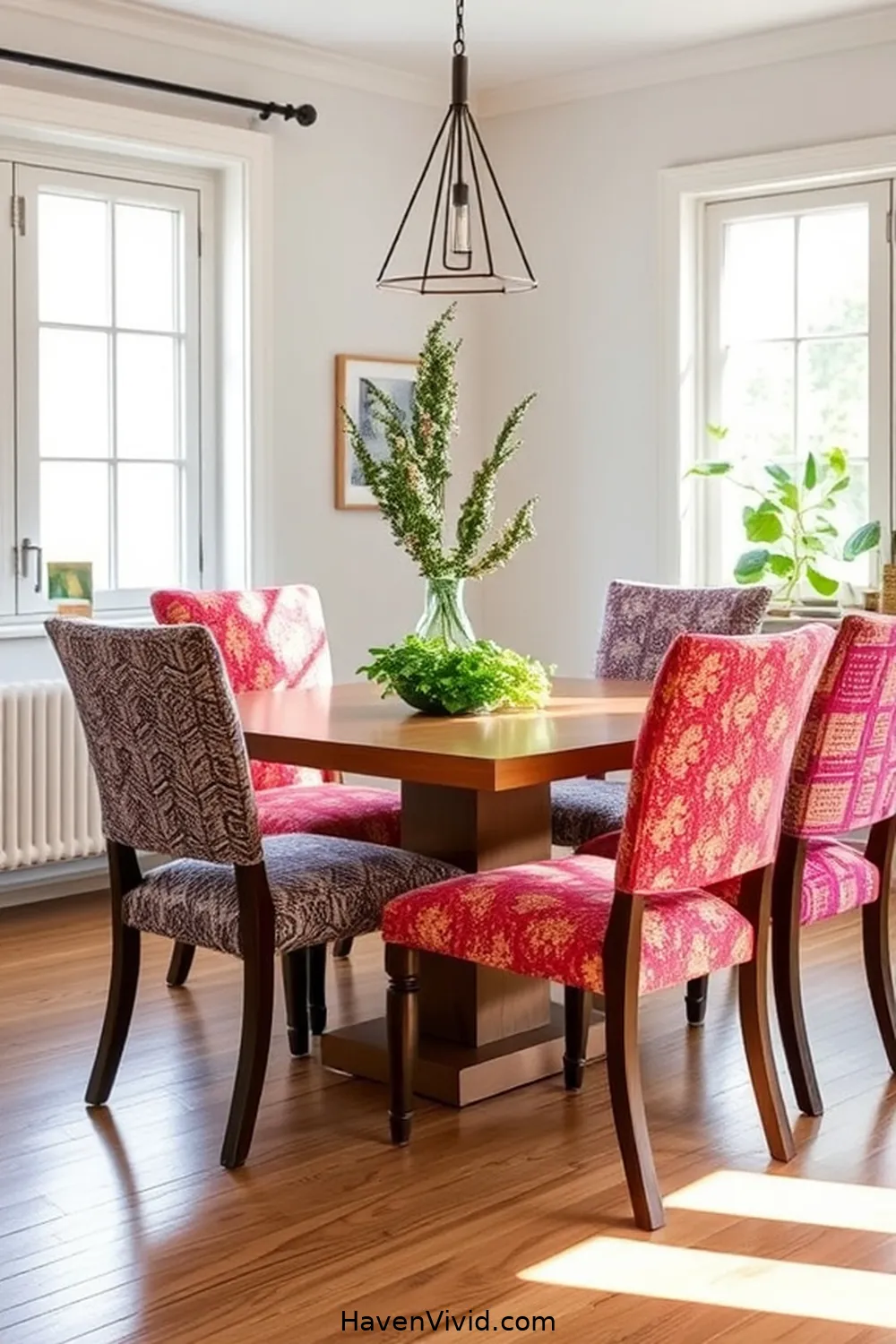
Transforming dining chairs with upcycled upholstery can breathe new life into your minimalist dining room. I love finding unique fabrics that tell a story, making each chair a conversation piece. With just a few steps, you can create a stunning focal point.
Here’s a simple guide to help you get started:
| Step | Description | Tools Needed |
|---|---|---|
| Choose Fabric | Select vibrant, durable fabric | Scissors, measuring tape |
| Remove Old Fabric | Carefully take off old upholstery | Staple remover, screwdriver |
| Cut & Attach | Cut new fabric, staple it on | Stapler, fabric scissors |
| Final Touches | Add decorative elements | Trim, buttons, or paint |
Recommended Items
Here are our recommended products and equipment to help you embrace a minimalist dining room—feel free to explore!
Crafting a Unique Table Runner From Scraps
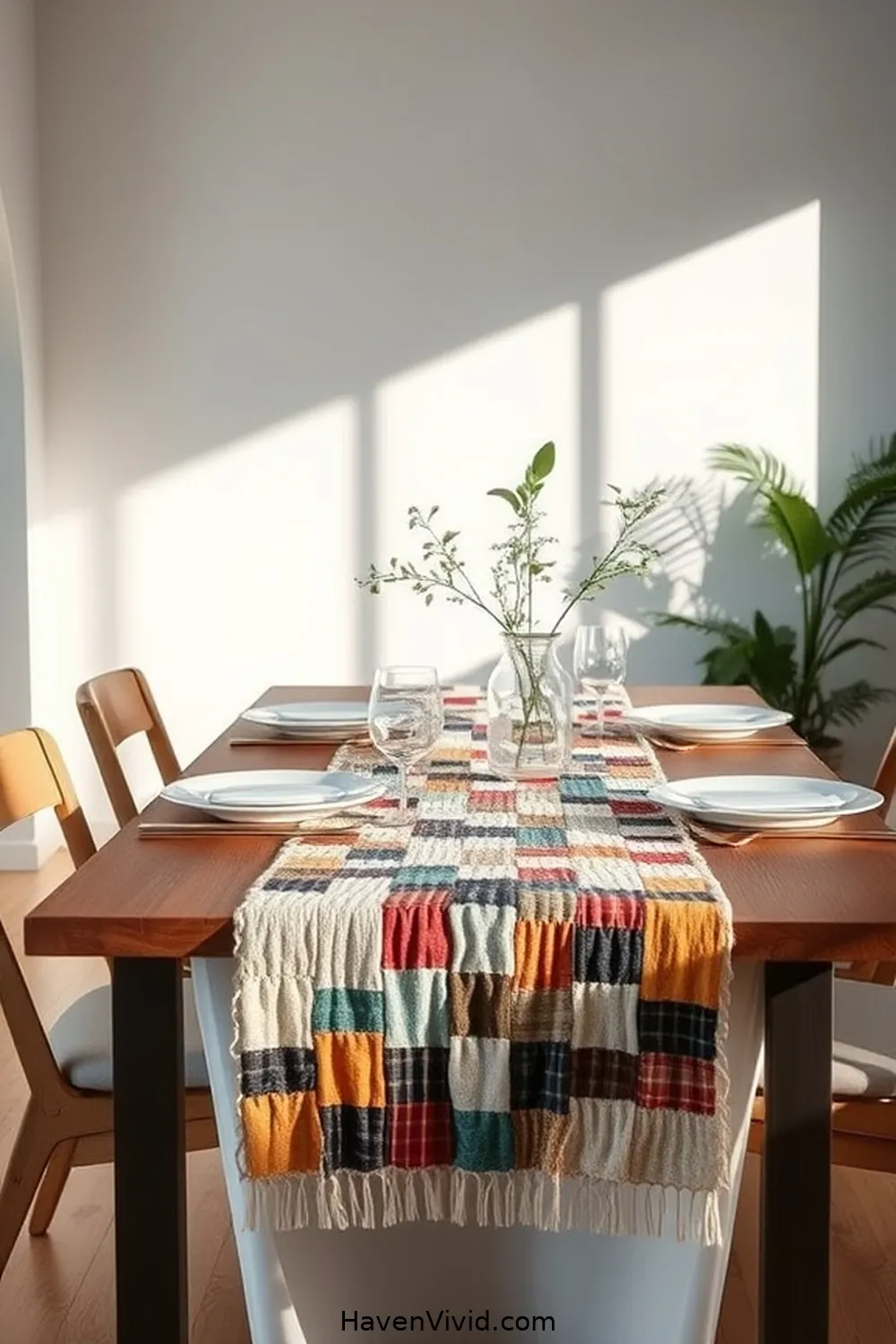
Crafting a unique table runner from fabric scraps not only adds a personal touch to your minimalist dining room but also showcases your creativity and commitment to sustainability.
I love the way each piece tells a story, bringing character to my table. To get started, gather your materials and let your imagination flow:
Each fabric scrap holds a unique story, adding charm and personality to your dining experience.
- Scraps of different colors and textures
- Sewing machine or needle and thread
- Scissors for trimming
- Iron for smoothing edges
- A measuring tape for precision
Arrange the scraps in a way that pleases your eye, then sew them together.
Whether you opt for a patchwork design or a more abstract arrangement, you’ll create a stunning centerpiece that reflects your personality while honoring the environment.
Happy crafting!
Step-by-Step Guide for Upcycled Fabric Decor
DIY Napkins and Placemats for a Cohesive Look
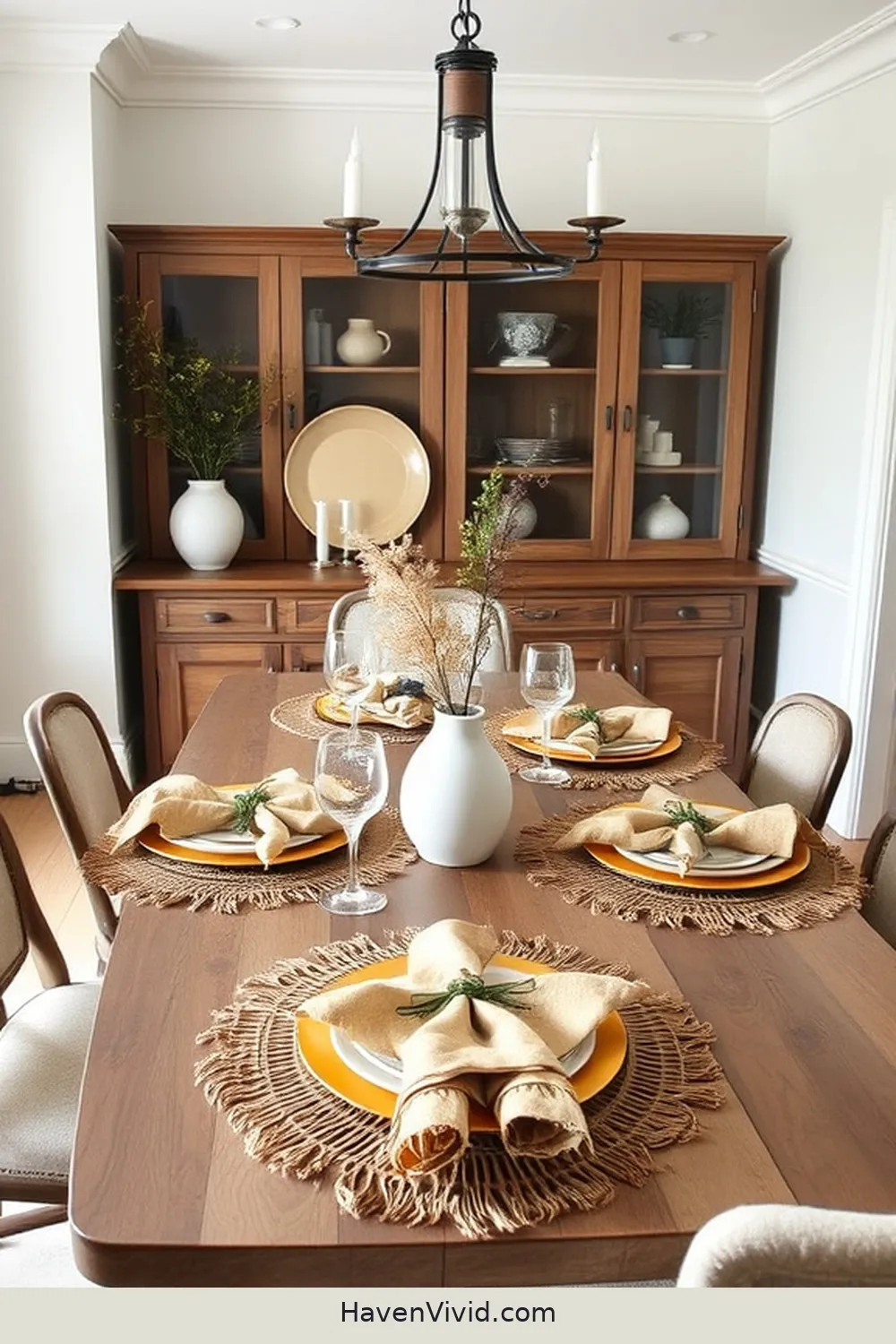
Building on the charm of your unique table runner, creating DIY napkins and placemats can further unify the aesthetic of your minimalist dining room.
I love choosing upcycled fabric that complements my runner’s colors and textures, ensuring everything flows seamlessly. To make napkins, I cut squares from the fabric, allowing for frayed edges that add a rustic touch.
For placemats, I opt for larger rectangles, layering them for depth. Experimenting with different patterns keeps the look fresh, while the tactile quality of the fabric invites warmth into the space.
These simple, handmade elements not only enhance the dining experience but also reflect my commitment to sustainability, showcasing creativity without the clutter.
It’s a beautiful way to embrace minimalism!
Creating Wall Art With Upcycled Fabric

While many people overlook the walls in their minimalist dining rooms, I find that creating wall art with upcycled fabric can breathe new life into the space.
Transform your minimalist dining room walls with vibrant upcycled fabric art for a touch of creativity and sustainability.
It’s not just about decoration; it’s about expressing creativity and sustainability. Here’s how I bring my walls to life:
- Choose vibrant fabrics: I hunt for patterns that resonate with my style.
- Frame fabric squares: Simple frames elevate the fabric’s visual appeal.
- Create a fabric collage: Mixing textures and colors adds depth.
- Hang fabric banners: They’re playful and can be seasonal.
- Incorporate natural elements: Pairing fabric with wood or metal brings warmth.
Each piece tells a story, and my dining room becomes a canvas of memories and artistic expression.
Enhancing Lighting With Fabric Lampshades

When I want to elevate the ambiance of my minimalist dining room, enhancing lighting with fabric lampshades becomes a key element. The soft glow from these shades creates a warm, inviting atmosphere perfect for gatherings. I love experimenting with different fabrics, colors, and patterns that resonate with my style. Here’s a quick overview of my favorite fabric choices:
| Fabric Type | Color Palette | Texture |
|---|---|---|
| Cotton | Soft pastels | Smooth |
| Linen | Earthy tones | Textured |
| Burlap | Neutral shades | Rustic |
| Velvet | Rich jewel tones | Luxurious |
| Recycled Denim | Cool blues | Casual |
Making a Statement With Fabric Tablecloths
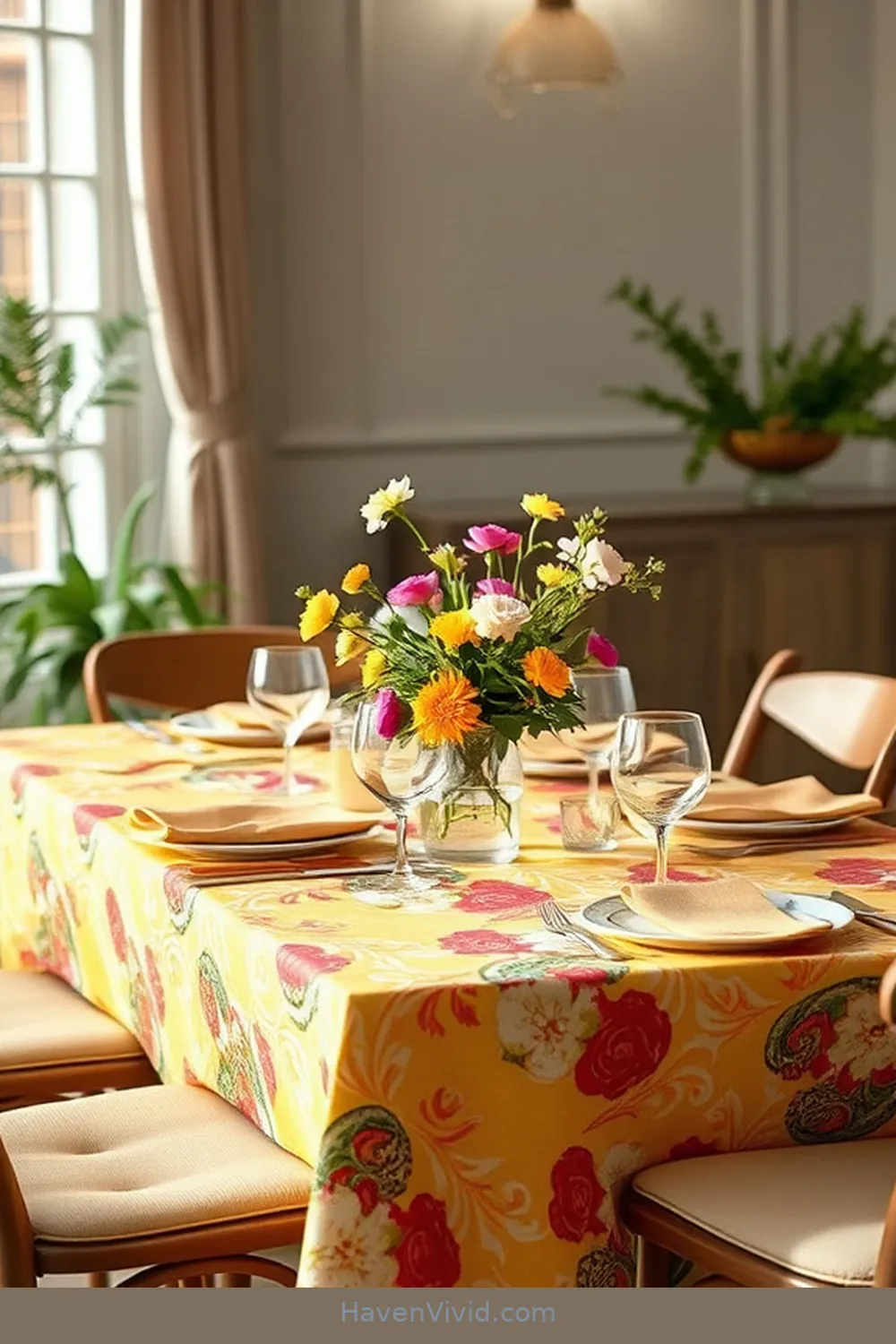
A stunning fabric tablecloth can completely transform the look of your dining room, serving as the centerpiece that draws everyone’s attention.
I’ve found that choosing the right tablecloth not only elevates the space but also reflects my personal style.
Here are some ideas to inspire you:
- Bold Patterns: Choose vibrant colors or geometric designs for a lively atmosphere.
- Natural Fabrics: Opt for linen or cotton for a soft, inviting feel.
- Layering: Combine a patterned cloth with a solid one for added depth.
- Seasonal Themes: Switch them out to match holidays or seasons for a fresh look.
- Personal Touch: Use upcycled fabrics with sentimental value for a unique statement.
With these tips, you’ll create a dining experience that’s both stylish and meaningful.
Repurposing Old Fabrics Into Storage Solutions
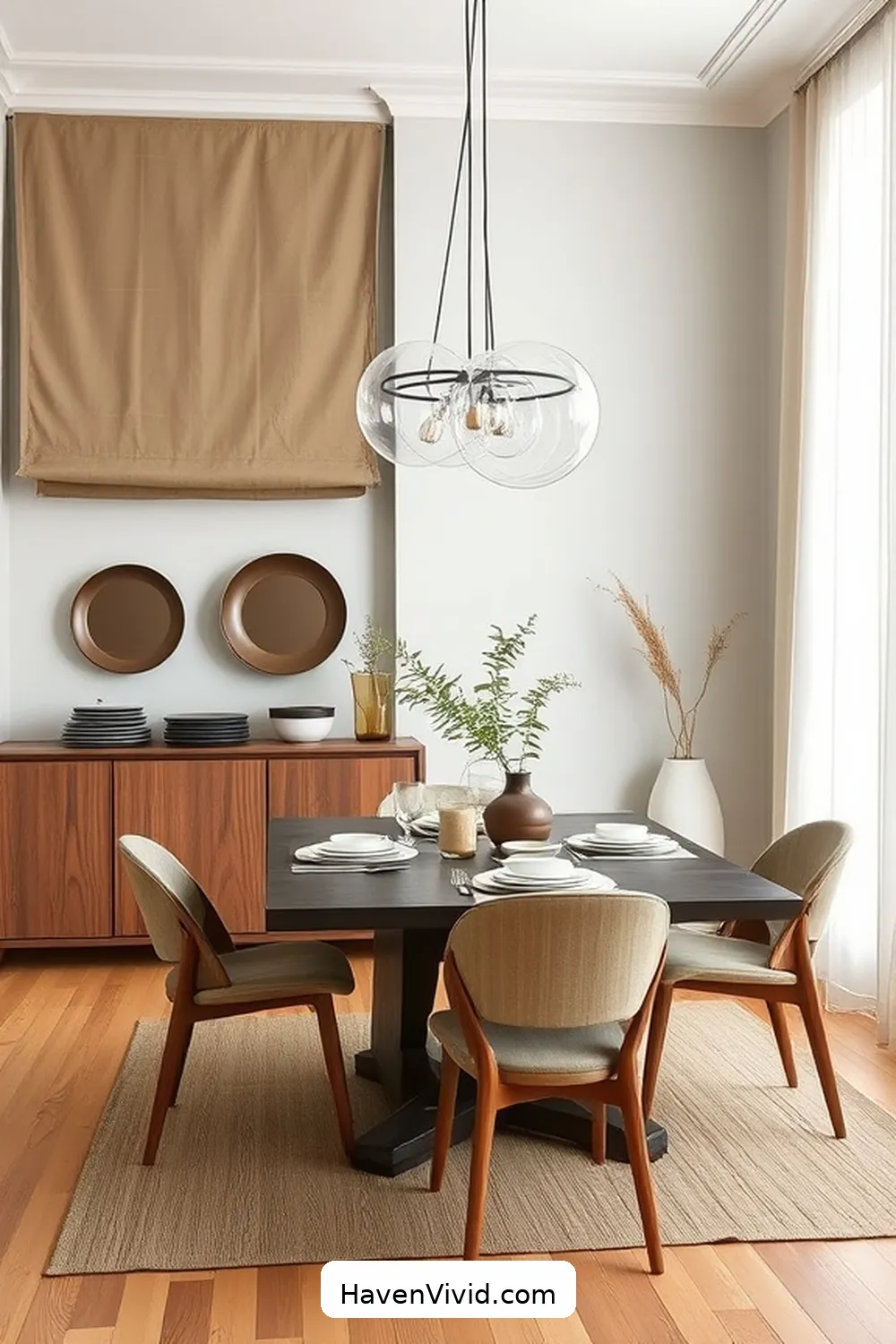
Choosing the right tablecloth can be just the beginning of how you incorporate fabric into your dining space.
I love repurposing old fabrics into stylish storage solutions that not only declutter but also add a personal touch. For instance, I transform worn-out curtains into fabric bins; they’re perfect for stashing napkins or utensils. Simply cut them to size, sew or glue the edges, and voilà! You’ve got unique, eco-friendly storage.
I’ve also created charming fabric-covered boxes from leftover upholstery scraps, giving a fresh life to forgotten materials. These solutions aren’t only functional but also tell a story, reminding me of my creative journey.
Embracing this approach truly enhances my dining room’s minimalist aesthetic while remaining practical.
Incorporating Color and Texture Mindfully
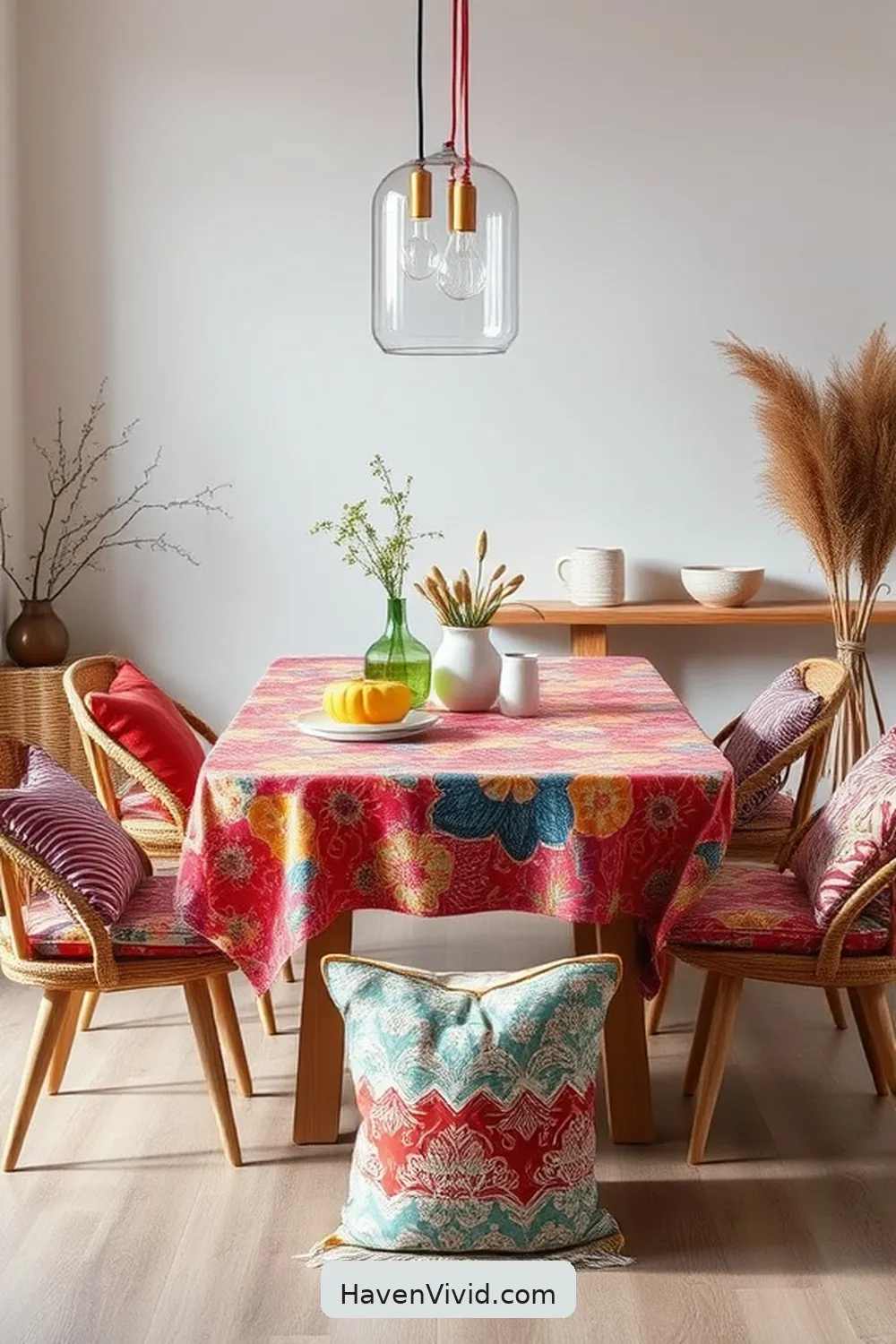
While I embrace the minimalist ethos in my dining room, incorporating color and texture mindfully can truly elevate the space.
I’ve found that small touches can make a dramatic difference without overwhelming the simplicity I love. Here’s how I do it:
- Accent pillows: A single, vibrant pillow on a neutral chair adds warmth.
- Table runner: A handwoven fabric runner introduces both color and tactile interest.
- Artisan ceramics: Unique, handcrafted dishes serve as functional decor.
- Natural elements: Fresh flowers or greenery bring life and subtle texture.
- Layered fabrics: Mixing different textures, like linen and cotton, creates depth while keeping it cohesive.
These thoughtful additions breathe life into my dining area, making it a welcoming and inspiring space.
Sustainable Practices for Fabric Care

Caring for the fabrics in my minimalist dining room is just as important as selecting them. I always opt for gentle, eco-friendly detergents that preserve the integrity of my upcycled textiles.
Instead of tossing everything in the wash, I spot-clean when possible, saving both water and energy. I also hang my fabrics to dry, allowing the fresh air to work its magic, rather than relying on a dryer.
Regularly rotating and fluffing my cushions helps maintain their shape, while a simple vacuum keeps dust at bay.
Showcasing Personal Stories Through Fabric

How can a simple piece of fabric tell a story? Each thread weaves a memory, a moment, or an emotion.
When I look at my upcycled fabric tablecloth, I remember family gatherings and laughter echoing through the room. It’s not just fabric; it’s nostalgia.
Here’s how to showcase your personal stories through fabric:
- Choose meaningful patterns that reflect your journey
- Incorporate heirloom pieces like vintage napkins or table runners
- Create a fabric collage that narrates your life events
- Use fabric swatches from travels to spark conversations
- Drape fabrics that remind you of loved ones, infusing warmth
Embracing Functionality in Minimalist Design

In a world where excess often clutters our lives, I find that embracing functionality in minimalist design transforms not just spaces but also our daily experiences. By prioritizing essential pieces, I create an inviting dining room that balances beauty with purpose.
Every item has its place, from a sleek table that invites conversation to chairs that blend comfort with style. I choose upcycled fabric for cushions, adding warmth while telling a story. This intentionality fosters a serene atmosphere, allowing me to focus on what truly matters—connecting with loved ones.
When everything serves a purpose, I feel lighter, more at ease. Minimalism isn’t just about the look; it’s about enhancing our daily lives with thoughtful, functional design.
Inspiring Upcycling Projects for Every Skill Level
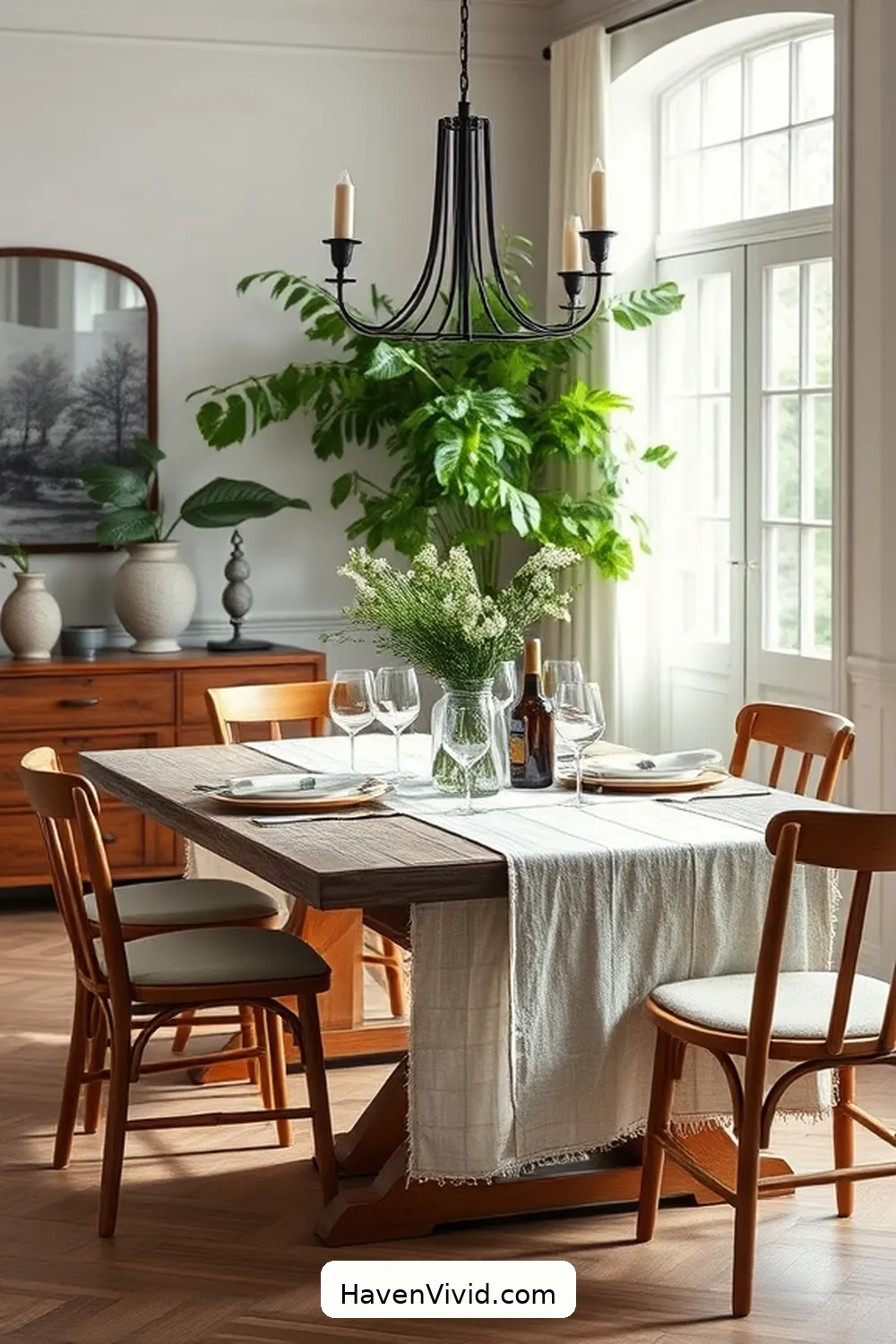
While I’ve always appreciated the charm of upcycled projects, it’s the thrill of transforming everyday items into something beautiful and functional that truly excites me.
If you’re enthusiastic to embark on upcycling, here are some inspiring projects for every skill level:
- Fabric Scrap Table Runner: Stitch together colorful scraps for a unique dining table accent.
- Reclaimed Wood Placemats: Sand down old wood for rustic, durable placemats.
- Mason Jar Candle Holders: Wrap jars in fabric for a cozy, ambient glow.
- Old T-Shirt Cushions: Sew together old tees for comfy, casual seating.
- Vintage Fabric Wall Art: Frame fabric swatches for eye-catching decor.
Each of these projects brings a touch of creativity and sustainability to your dining space.
Let’s get crafting!











